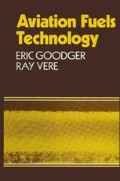Abstract
The overall process of combustion of fuel for the generation of power by an open-circuit heat engine comprises the metering of the fuel to the combustion chambers, the preparation of the fuel-oxidant mixture, initiation of ignition, propagation and/or stabilisation of the flame, and subsequent emission of the products. The devices or complete systems used for engine fuel metering represent a separate study, and are covered elsewhere. The remaining topics are determined largely by the type of engine and combustion adopted, and are outlined individually in the following sections.
Preview
Unable to display preview. Download preview PDF.
8.4 References
J. L. Jackson, Spontaneous ignition temperatures of pure hydrocarbons, NACA RM E50J10, 1950
ASTM-D2155–66, Standard method of test for autoignition temperature of liquid petroleum products, American Society for Testing and Materials, Philadelphia, Pennsylvania
W. Lovell, ‘Knock characteristics of hydrocarbons’, Ind. Eng. Chem., Vol. 40, 1948, pp. 2388–438
E. M. Goodger, Hydrocarbon Fuels, Macmillan, London, 1975
W. Houtman, ‘Development of EPA aircraft piston engine emission standards’, Aircraft Piston Engine Exhaust Emission Symposium, Lewis Research Center, Cleveland, NASA CP-2005, September 1976
B. J. Rezy, K. J. Stuckas, J. R. Tucker and J. E. Meyers, Exhaust emissions reduction for intermittent combustion aircraft engines, NASA CR-16794, May 1982
R. Friedman, Aviation turbine fuel properties and their trends, SAE 810850, August 1981
ASTM D3343, Standard method for estimation of hydrogen content of aviation fuels, American Society for Testing and Materials, Philadelphia, Pennsylvania
C. D. Hurley, Hydrogen content correlation for petroleum and nonpetroleum derived hydrocarbon fuels, NGTE M 81029, July 1981
C. C. Gleason, T. L. Oller, M. W. Shayeson and D. W. Bahr, (a) Evaluation of fuel character effects on J79 engine combustion system, AFAPL-TR-79–2015, June 1979, (b) Evaluation of fuel character effects on F101 engine combustion system, AFAPL-TR-79–2018, June 1979
R. M. Schirmer, L. A. McReynolds and J. E. Daley, ‘Radiation from flames in gas turbine combustors’, SAE Trans., Vol. 68, 1960, pp. 554–61
W. G. Dukek, Survey of hydrogen content of Exxon jet fuels, Technical Division J on Aviation Fuels, Phoenix, Arizona, December 1981
J. S. Fear, NASA broad-specification fuels combustion technology program status and description, ASME 80-GT-65
H. F. Butze and A. L. Smith, Effect of fuel properties on performance of a single aircraft turbojet combustor at simulated idle, cruise and take-off conditions, NASA TM 73780, September 1977
R. M. Schirmer and H. T. Quigg, High pressure combustor studies of flame radiation as related to hydrocarbon structure, Phillips Petroleum Company, Research Division Report 3952–65R, May 1965
D. W. Naegeli and C. A. Moses, Effect of fuel molecular structure on soot formation in gas turbine engines, ASME 80-GT-62
E. Zahavi, B. Gas-Orr and A. Burcat, ‘Effect of future jet fuel characteristics on adiabatic flame temperatures and combustion products distribution’, J. I. Energy, March 1982
J. P. Longwell and J. Grobman, Alternative aircraft fuels, ASME 78-GT-59
D. W. Bahr, Impacts of broadened-specifications fuels on aircraft turbine engine combustors, ASME 81-GT-2
A. B. Wassell, A U.K. view of future fuels, ASME 81-GT-87
A. G. Robertson and R. E. Williams, ‘Jet fuel specifications — the need for change’, Shell Aviation News, No. 435, 1976, pp. 10–13
H. F. Butze and R. C. Ehlers, Effect of fuel properties on performance of a single aircraft turbojet combustor, NASA TM X-71789, October 1975
R. Roberts, A. Peduzzi and G. E. Vitti, Experimental clean combustor program, Phase II, NASA CR-134970, July 1976
E. K. Bastress and R. S. Fletcher, Aircraft engine exhaust emissions, ASME 65-WA/APC-4, November 1969
H. Meier Zu Kocker, ‘Kinetics of soot formation-investigations into the mechanism of soot formation in hydrocarbon diffusion flames, Combustion Science and Technology’, Vol. 5, 1972, pp. 219–24
A. M. Mellor, ‘Gas turbine engine pollution’, Prog. Energy Combust. Sci., Vol. 1, 1976, pp. 111–33
W. S. Blazowski and R. E. Henderson, Aircraft exhaust pollution and its effect on the U.S. Air Force, AFAPL-TR-74–64, August 1974
Author information
Authors and Affiliations
Copyright information
© 1985 Eric Goodger and Ray Vere
About this chapter
Cite this chapter
Goodger, E., Vere, R. (1985). Fuel Combustion Performance. In: Aviation Fuels Technology. Palgrave, London. https://doi.org/10.1007/978-1-349-06904-0_8
Download citation
DOI: https://doi.org/10.1007/978-1-349-06904-0_8
Publisher Name: Palgrave, London
Print ISBN: 978-1-349-06906-4
Online ISBN: 978-1-349-06904-0
eBook Packages: EngineeringEngineering (R0)

